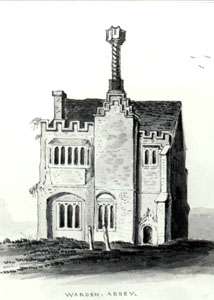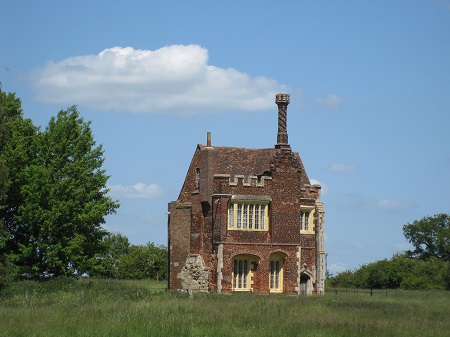Wardon Abbey from 1537
This page was written by Margaret Roberts, Volunteer Historian, Warden Abbey Vineyard.
On 4 December 1537 Abbot Henry Emery and his thirteen monks surrendered the ‘Monastery of Wardon’ to representatives of Henry VIII. They relinquished not only the ‘site, soil, circuit and precinct’ of the monastery, but also its contents. Their properties elsewhere in Bedfordshire, Hertfordshire, Northamptonshire, Buckinghamshire, Cambridgeshire, Huntingdonshire, Norfolk and Suffolk, as well as in the parish of St John Zachary (City of London), all fell to the Crown.
Cattle overwintered in the precinct while arrangements were made for its future. By Michaelmas 1538 the Abbot’s Garden Grange (one of the two monastic home farms) had been renamed Farm of Demesne Lands, a survey carried out and rental valuation of £13 19s 8d agreed for both farm and site of the late abbey. The neighbouring home farm, Park Grange, was valued at £27 5s.
On 24 January 1539 the Crown granted a 21-year lease for the site and Farm of Demesne Lands to Sir Francis Bryan who had been the steward of Woburn Abbey, and he in turn sublet the property to Robert Gostwick, previously one of the abbot of Wardon’s bailiffs. When Robert Gostwick and his wife Anne acquired the lease in 1545, it was conditional upon the abbey buildings being dismantled and the stone removed. Redevelopment work probably began soon afterwards, and by November 1558 the Gostwick family occupied a modest but fashionable Tudor manor house on the site of the monks’ infirmary cloister. Several new agricultural buildings stood close by.

Fragment of Tudor manor house (late 18th/early 19th century) [ref: Z50/129/56]
After Robert Gostwick died in 1561, the site and precinct were leased to a series of tenants, all of whom held it as part of a wider portfolio. Gaps remain, but it is known that Arthur Grey, 14th Baron Grey of Wilton, took possession from the Crown in 1569. Four generations of the Morison family of Cassiobury (Herts) held the lease from 1587/88 until the mid-17th century. Most notable was the husband of Elizabeth Morison, the staunch royalist Arthur Capel who was beheaded shortly after the execution of Charles I in 1649.
Against the background of the king’s imprisonment by the Parliamentarians, foppish lawyer Ralph Bovey began taking steps to acquire land at Old Warden early in 1648. During a series of transactions that took almost 20 years to complete, he took possession of the lease on Park Grange, the site of the abbey, its precinct, and those parts of the Abbot’s Garden that had lain outside the precinct boundary. Sir Ralph died in 1679 leaving his illegitimate son Charles as heir. After Charles died in 1713 Wardon was held by trustees on behalf of his son, Charles junior. However, the young man died in 1728 before reaching his majority, leaving the Reverend Thomas Davies (Sir Ralph Bovey’s great-nephew) to inherit on condition that he adopted the name of Bovey.

Estate map (1750). Site of the late abbey [white], Great Vineyard [mint green] and Little Vineyard [lighter green] [ref: Z1125/1]
The Reverend Davis Bovey passed away in 1733 leaving everything to his 15-month old daughter Katherine. She was married off soon after her 18th birthday in 1750 and the estate map drawn up before her wedding to Thomas Alston of Odell provides evidence of the layout both of the former Abbot’s Garden and of Park Grange [ref: Z1125/1]. Katherine’s inheritance immediately became the right of her husband, but they parted within 2 years. She recovered her assets after Thomas Alston died in 1774, and in 1778 everything passed to John Wasse, her illegitimate son by long-term partner, John Wasse senior. Young John, who came of age in 1781, was responsible for demolishing the Tudor manor house in 1785. Just one fragment remained standing by July 1786 when brewer and MP Samuel Whitbread purchased the site of the late abbey and its demesne land along with Garnars Farm, Clay Pitt Farm, Whittemores Farm, Prestons Farm, Park Grange Farm, Inskipps Farm, Sweet Briar Farm, and Deadmans Oak Farm.
The Whitbread family redeveloped the site in the late 18th century, knocking down dilapidated outbuildings and constructing Abbey Farm where lay brothers and guests once worshipped in the nave of the abbey church. The working farmland remains in Whitbread family hands as part of the Southill Estate; access is not permitted and there are no public rights of way through the former precinct.

Fragment of Tudor manor house (2015) (Image copyright M.Roberts)
The fragment of the Tudor manor house was renovated by the Landmark Trust in the mid-1970s and opened as a holiday let in 1976. Nearly five acres of the former monastic vineyard were replanted by Lady Whitbread in 1986 and having been leased by Bedfordshire Rural Communities Charity since 2010, offer a unique resource for the local community. Apart from the path of a Victorian railway line (now defunct) running through the former precinct, and the late 18th-century road leading from Old Warden to Cardington, the landscape has changed little since Wardon Abbey was dissolved in 1537.
For further details, see The Site and Precinct of the late Wardon Abbey from 1537 onwards